Dual cyclin-dependent kinase 4/6 inhibition by PD-0332991 induces apoptosis and senescence in oesophageal squamous cell carcinoma cells
- PMID: 28444744
- PMCID: PMC5513862
- DOI: 10.1111/bph.13836
Dual cyclin-dependent kinase 4/6 inhibition by PD-0332991 induces apoptosis and senescence in oesophageal squamous cell carcinoma cells
Abstract
Background and purpose: Aberrant activation of the cyclin D1-cyclin-dependent kinase 4/6 (CDK4/6)-Rb signalling pathway is common in oesophageal squamous cell carcinoma (ESCC). PD-0332991, a highly specific inhibitor of CDK4/6, has potent antitumour activity against many types of cancer. The purpose of this study was to examine the in vitro and in vivo antineoplastic effect of PD-0332991 against the growth and metastasis of ESCC cells.
Experimental approach: Cell viability and any synergy between PD-0332991 and 5-fluorouracil or cisplatin were measured by MTS assay and CalcuSyn software respectively. Cell migration and invasion were detected by wound healing and transwell assays. Apoptosis was evaluated by flow cytometry after staining annexin V-FITC/PI. Cellular senescence was assessed by measuring SA-β-gal activity. Nude mouse xenograft models of ESCC were employed to determine the in vivo activity of PD-0332991 against tumour growth and lung metastasis.
Key results: PD-0332991 inhibited cellular growth and induced mitochondrial-dependent apoptosis in ESCC cells. PD-0332991 also suppressed migration, invasion and the expression of MMP-2 in ESCC cells. Furthermore, PD-0332991 treatment caused cell senescence in a FOXM1-dependent manner. In addition, there was synergy between PD-0332991 and cisplatin or 5-fluorouracil. Importantly, the xenografted tumour experiments demonstrated that PD-0332991 potently inhibits ESCC cell growth and lung metastasis.
Conclusions and implications: PD-0332991 can elicit a strong antitumour activity against ESCC growth and metastasis and may be a promising candidate drug for the treatment of patients with ESCC. Our results warrant a clinical trial to further evaluate the efficacy of PD-0332991 in ESCC patients, even those with metastasis.
© 2017 The British Pharmacological Society.
Figures

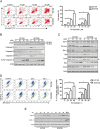
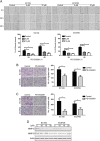
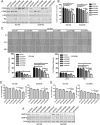
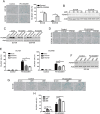

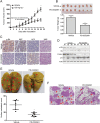
Similar articles
-
CDK4/6 inhibitor-SHR6390 exerts potent antitumor activity in esophageal squamous cell carcinoma by inhibiting phosphorylated Rb and inducing G1 cell cycle arrest.J Transl Med. 2017 Jun 2;15(1):127. doi: 10.1186/s12967-017-1231-7. J Transl Med. 2017. PMID: 28578693 Free PMC article.
-
Pristimerin targeting NF-κB pathway inhibits proliferation, migration, and invasion in esophageal squamous cell carcinoma cells.Cell Biochem Funct. 2018 Jun;36(4):228-240. doi: 10.1002/cbf.3335. Epub 2018 May 20. Cell Biochem Funct. 2018. PMID: 29781107
-
Ivermectin suppresses tumour growth and metastasis through degradation of PAK1 in oesophageal squamous cell carcinoma.J Cell Mol Med. 2020 May;24(9):5387-5401. doi: 10.1111/jcmm.15195. Epub 2020 Mar 31. J Cell Mol Med. 2020. PMID: 32237037 Free PMC article.
-
Applications and mechanisms of the cyclin-dependent kinase 4/6 inhibitor, PD-0332991, in solid tumors.Cell Oncol (Dordr). 2022 Dec;45(6):1053-1071. doi: 10.1007/s13402-022-00714-4. Epub 2022 Sep 10. Cell Oncol (Dordr). 2022. PMID: 36087253 Review.
-
Linking FOXM1 and PD-L1 to CDK4/6-MEK targeted therapy resistance in malignant peripheral nerve sheath tumors.Oncotarget. 2024 Sep 30;15:638-643. doi: 10.18632/oncotarget.28650. Oncotarget. 2024. PMID: 39347707 Free PMC article. Review.
Cited by
-
Long non-coding RNA DANCR promotes cell proliferation, migration, invasion and resistance to apoptosis in esophageal cancer.J Thorac Dis. 2018 May;10(5):2573-2582. doi: 10.21037/jtd.2018.04.109. J Thorac Dis. 2018. PMID: 29997918 Free PMC article.
-
CDK4/6-mediated phosphorylation of DUB3 promotes YAP1 stability and hepatocellular carcinoma progression.Cell Death Discov. 2025 Apr 30;11(1):212. doi: 10.1038/s41420-025-02493-x. Cell Death Discov. 2025. PMID: 40307228 Free PMC article.
-
Palbociclib Induces the Apoptosis of Lung Squamous Cell Carcinoma Cells via RB-Independent STAT3 Phosphorylation.Curr Oncol. 2022 Aug 18;29(8):5855-5868. doi: 10.3390/curroncol29080462. Curr Oncol. 2022. PMID: 36005200 Free PMC article.
-
Therapeutic Challenge with a CDK 4/6 Inhibitor Induces an RB-Dependent SMAC-Mediated Apoptotic Response in Non-Small Cell Lung Cancer.Clin Cancer Res. 2018 Mar 15;24(6):1402-1414. doi: 10.1158/1078-0432.CCR-17-2074. Epub 2018 Jan 8. Clin Cancer Res. 2018. PMID: 29311118 Free PMC article.
-
A Regulatory Noncoding RNA, nc886, Suppresses Esophageal Cancer by Inhibiting the AKT Pathway and Cell Cycle Progression.Cells. 2020 Mar 26;9(4):801. doi: 10.3390/cells9040801. Cells. 2020. PMID: 32225025 Free PMC article.
References
-
- Baughn LB, Di Liberto M, Wu K, Toogood PL, Louie T, Gottschalk R et al. (2006). A novel orally active small molecule potently induces G1 arrest in primary myeloma cells and prevents tumor growth by specific inhibition of cyclin‐dependent kinase 4/6. Cancer Res 66: 7661–7667. - PubMed
MeSH terms
Substances
LinkOut - more resources
Full Text Sources
Other Literature Sources
Medical
Research Materials
Miscellaneous

